A liveblogging solution for Plone.
Project description
Life, the Universe, and Everything
A liveblog is a blog post which is intended to provide a rolling textual coverage of an ongoing event.
A liveblog is continuously updated with timestamped micro-updates which are placed above previous micro-updates.
Typical use case is the following:
The publisher of a news site creates a liveblog
Editors add micro-updates to the liveblog as the event goes on
Visitors of the site on the liveblog get micro-updates automatically via AJAX calls
Who is using it?
These are some of the sites using collective.liveblog:
CartaCapital (BR)
Portal Brasil 2016 (BR)
Mostly Harmless



Got an idea? Found a bug? Let us know by opening a support ticket.
Don’t Panic
Installation
To enable this package in a buildout-based installation:
Edit your buildout.cfg and add add the following to it:
[buildout] ... eggs = collective.liveblog
After updating the configuration you need to run ‘’bin/buildout’’, which will take care of updating your system.
Go to the ‘Site Setup’ page in a Plone site and click on the ‘Add-ons’ link.
Check the box next to collective.liveblog and click the ‘Activate’ button.
Usage
After installing the package you will see a new content type available: Liveblog.
A liveblog has a title, a description and an image field. The image field is used to set up a header on the liveblog.
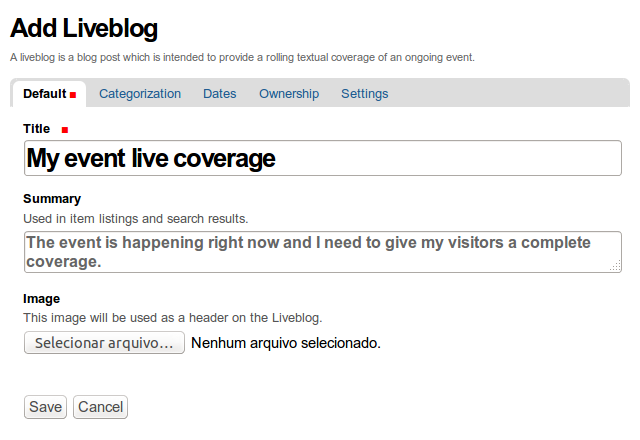
Before feeding the liveblog with micro-updates you will need to activate it. Now, go to the Update tab and start writing micro-updates.
A micro-update is basically a text that should optionally have a title. The date and time of the micro-update is automatically recorded for you. After publishing a micro-update you will see it on top of your liveblog before all previous micro-updates.
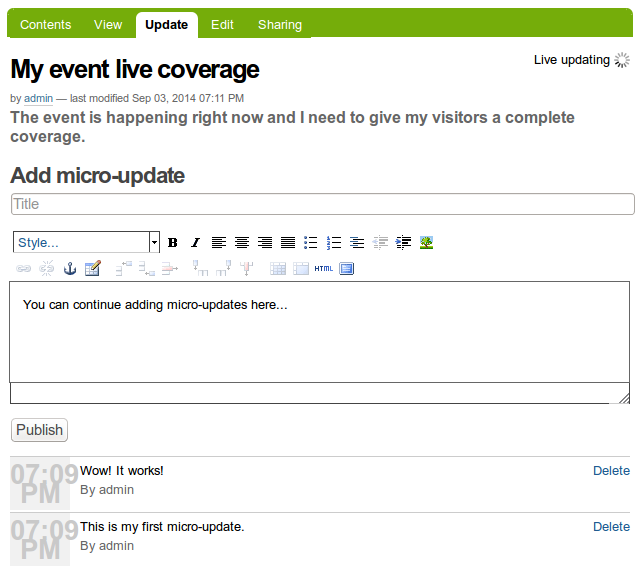
All people viewing your liveblog will receive automatic updates every minute.
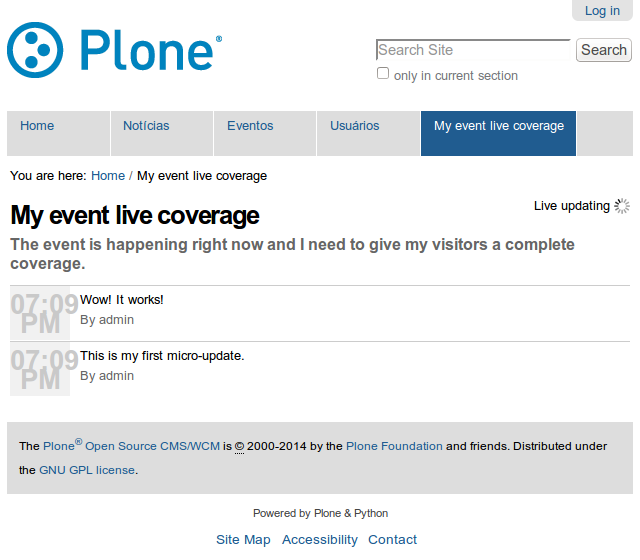
Micro-updates can be viewed as separate pieces of content; this makes easy to share them in social networks.
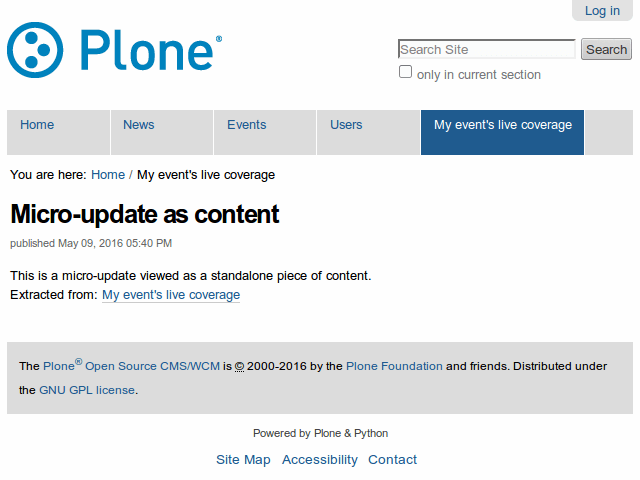
Many editors can update the liveblog safely. When another editor adds a micro-update you will see it automatically on your screen even if you are writing a new one.
You can delete micro-updates also. This will trigger a complete page refresh on all current viewers to avoid the displaying of invalid content in your liveblog. The page refresh will happen withing the next minute. If another editor deletes a micro-update you will see a message on your screen but no content refresh will take place. This way we avoid interrupting editors from their work.
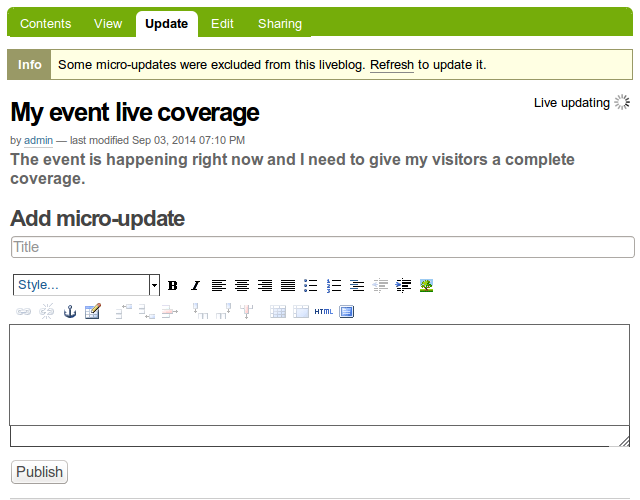
When a liveblog is not going to be updated anymore you should deactivate it.
Workflow
The package defines a workflow to be used with the content type (Liveblog Workflow).
The workflow defines 3 states: private, active and inactive. Liveblogs are created in the private state. When activated, the liveblog will be published and automatic refresh of micro-updates will be enabled. When deactivated, the liveblog will remain public, but automatic refresh of micro-updates will be disabled. No micro-updates can be added to a liveblog in inactive state. To continue adding micro-updates, just activate the liveblog again.
How does it work
TBD.
Changelog
1.1b2 (2016-05-10)
Micro-updates are now traversable; this allows to share them as separate pieces of content (closes #19). [rodfersou, hvelarde]
Use POST as request method on form used to edit micro-updates. [hvelarde]
A new text field to describe the Liveblog was added. [hvelarde]
Remove dependency on five.grok (closes #5). [rodfersou]
Package is now compatible with Plone 5.0 and Plone 5.1. [hvelarde]
1.1b1 (2016-04-19)
Update view now uses batch pagination every 20 micro-updates to reduce load time for users with Editor role (closes #10). [hvelarde]
Depend on plone.batching; this drops support for Plone 4.2. [hvelarde]
Use POST as request method on form used to add micro-updates. [hvelarde]
Remove referenceable extra; Archetypes is no longer the default framework in Plone 5. Under Plone < 5.0 you should now explicitly add plone.app.referenceablebehavior to the eggs part of your buildout configuration. [hvelarde]
The dates of micro-updates older than today were not shown in liveblogs on private and inactive states (fixes #14). [hvelarde]
1.0b3 (2014-09-20)
Rendering of plone.abovecontenttitle and plone.belowcontenttitle viewlets was removed from the update view. [hvelarde]
Add styles for responsive (closes #7). [agnogueira]
Bylines on micro-updates now honor security settings and will be displayed to anonymous users only if they are allowed to see this information (closes #6). [hvelarde]
Editors can now edit micro-updates; a full refresh of the view will be scheduled after editing a micro-update to avoid displaying invalid content (closes #3). [hvelarde]
1.0b2 (2014-09-13)
An adapter listing the URLs to be purged when a Liveblog is modified was added. [ericof]
Refactor recent-updates view to get rid of the timestamp parameter. This way we avoid a potential source of DoS attacks. [hvelarde]
1.0b1 (2014-09-05)
Timestamp handling was simplified. [hvelarde]
Implement the Expires header on recent-updates view. This will help us control better how long the page is going to live. [hvelarde]
Add a workflow specific to liveblogs. The workflow defines 3 states: private, active and inactive. This way we can control when automatic refresh of micro-updates happens. [hvelarde]
Refresh the whole view when a micro-update has been deleted to avoid displaying invalid content. [hvelarde]
The header viewlet was including the html and body tags on rendering. [hvelarde]
Lack of id attribute on field text was preventing TinyMCE editor from loading on Plone 4.2. [hvelarde]
Fire ObjectModifiedEvent event on micro-updates deletion to invalidate caching on views. [hvelarde]
Implement handling of If-Modified-Since request header on recent-updates view. [hvelarde]
Markup of time tag used on automatic updates was fixed. [hvelarde]
1.0a1 (2014-09-01)
Initial release.
Project details
Release history Release notifications | RSS feed
Download files
Download the file for your platform. If you're not sure which to choose, learn more about installing packages.
Source Distribution
Hashes for collective.liveblog-1.1b2.tar.gz
| Algorithm | Hash digest | |
|---|---|---|
| SHA256 | d26f5e426c742d0046984ac124de7e2a0c89891d96c5b4cb04bf4eb06fcf707f |
|
| MD5 | 1a49267f3a0572beebbd506a404f0823 |
|
| BLAKE2b-256 | 4f143e9d8392f0a82527e50d041d59a371edad86de3dc6e54056a344e24bf882 |












